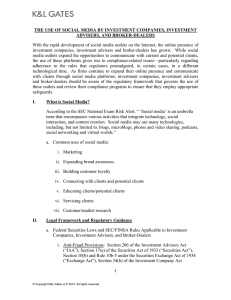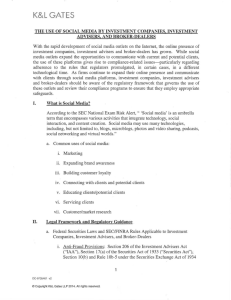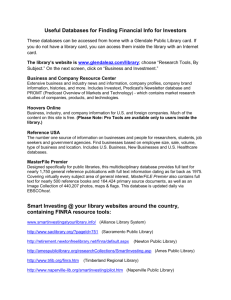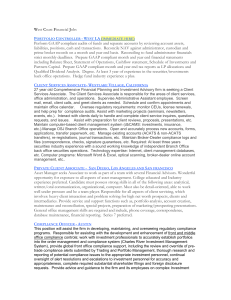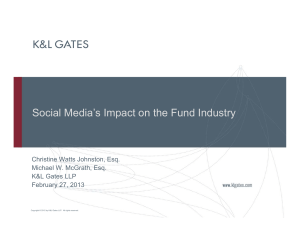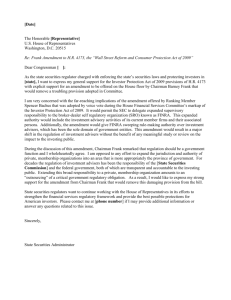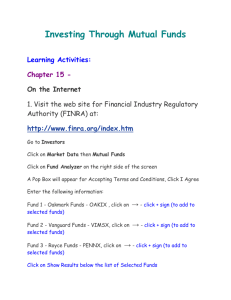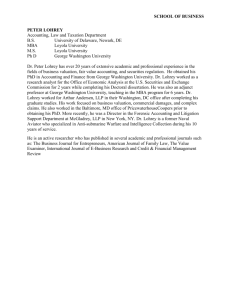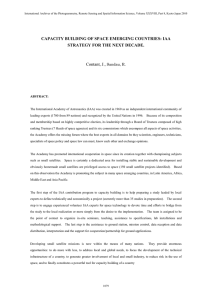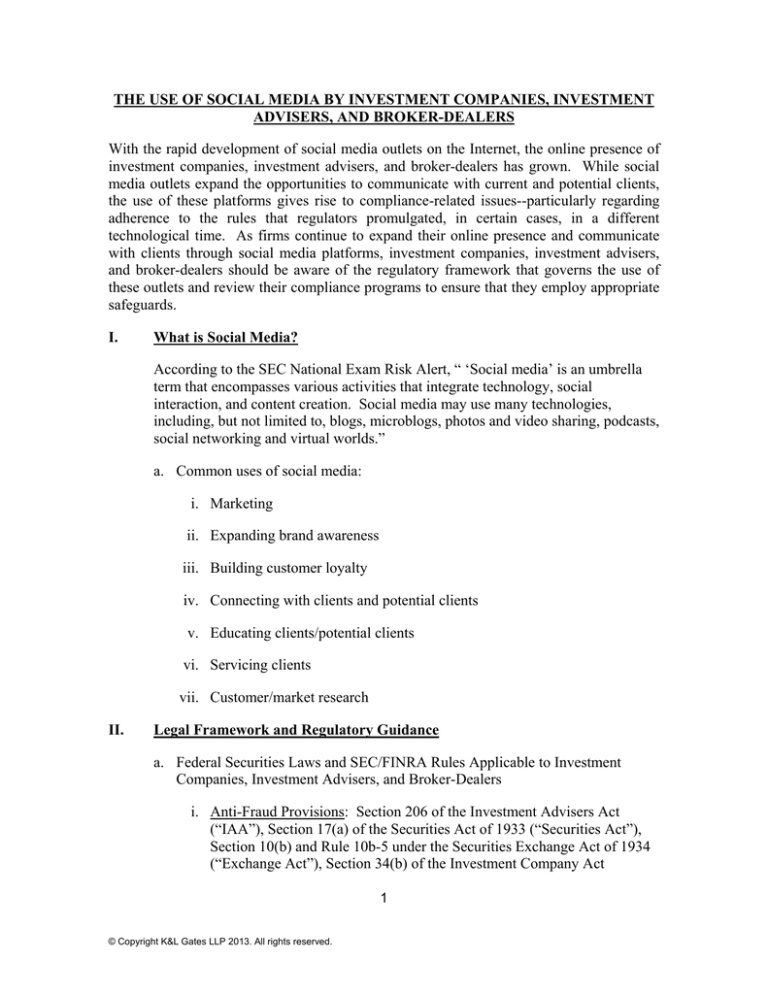
THE USE OF SOCIAL MEDIA BY INVESTMENT COMPANIES, INVESTMENT
ADVISERS, AND BROKER-DEALERS
With the rapid development of social media outlets on the Internet, the online presence of
investment companies, investment advisers, and broker-dealers has grown. While social
media outlets expand the opportunities to communicate with current and potential clients,
the use of these platforms gives rise to compliance-related issues--particularly regarding
adherence to the rules that regulators promulgated, in certain cases, in a different
technological time. As firms continue to expand their online presence and communicate
with clients through social media platforms, investment companies, investment advisers,
and broker-dealers should be aware of the regulatory framework that governs the use of
these outlets and review their compliance programs to ensure that they employ appropriate
safeguards.
I.
What is Social Media?
According to the SEC National Exam Risk Alert, “ ‘Social media’ is an umbrella
term that encompasses various activities that integrate technology, social
interaction, and content creation. Social media may use many technologies,
including, but not limited to, blogs, microblogs, photos and video sharing, podcasts,
social networking and virtual worlds.”
a. Common uses of social media:
i. Marketing
ii. Expanding brand awareness
iii. Building customer loyalty
iv. Connecting with clients and potential clients
v. Educating clients/potential clients
vi. Servicing clients
vii. Customer/market research
II.
Legal Framework and Regulatory Guidance
a. Federal Securities Laws and SEC/FINRA Rules Applicable to Investment
Companies, Investment Advisers, and Broker-Dealers
i. Anti-Fraud Provisions: Section 206 of the Investment Advisers Act
(“IAA”), Section 17(a) of the Securities Act of 1933 (“Securities Act”),
Section 10(b) and Rule 10b-5 under the Securities Exchange Act of 1934
(“Exchange Act”), Section 34(b) of the Investment Company Act
1
© Copyright K&L Gates LLP 2013. All rights reserved.
(“ICA”), FINRA Rule 2210, CFTC Regulation 180.1, and NFA
Compliance Rule 2-29.
ii. Advertising Rules: Rule 206(4)-1 under the IAA, FINRA Rule 2210,
Securities Act Rules 482 and 156, Rule 34b-1 under the ICA, CFTC
Regulation 4.41, and NFA Compliance Rule 2-29.
iii. Compliance/Supervision Rules: Rule 206(4)-7 under the IAA and Rule
38a-1 under the ICA, FINRA Rule 3130, CFTC Regulation 23.602, and
NFA Compliance Rule 2-29.
iv. Recordkeeping Rules: Rule 204-2 under the IAA, Exchange Act Rules
17a-3 and 17a-4, FINRA Rules 2210 and 4511, Section 31 and Rule 31a-2
under the ICA, CFTC Regulations 1.31, 4.7(b), 4.12, 4.23, and 4.33, and
NFA Compliance Rule 2-29.
v. Suitability: FINRA Rule 2310.
vi. Private Offerings: Reg D – 502(c); 506(c) and interaction with CFTC
Regulations 4.7(b) and 4.13(a)(3).
III.
Determining Whether Communication on a Social Media Platform is an
Advertisement
a. IAA Rule 206(4)-1
i. Advertising is any written communication addressed to more than one
person or any notice or announcement in any publication or by radio or
television which offers any analysis, report or publication regarding
securities; any graph, chart, formula or other device for making securities
decisions; or any other investment advisory services regarding securities.
ii. Rule 206(4)-1 may include e-mails, websites, or social media posts. If a
communication on a social media platform is not an “advertisement”
under IAA Rule 206(4)-1, investment advisers should still confirm that
the communication complies with the general anti-fraud provisions under
the IAA. If the communication on a social media platform is an
“advertisement” under IAA Rule 206(4)-1, the prohibitions under the
Rule must be considered as well:
1. Testimonials
2. Past specific recommendations
3. Graphs, charts and formulas
4. Free reports and services
2
© Copyright K&L Gates LLP 2013. All rights reserved.
5. Untrue statements of material fact and material omissions
IV.
Prior Approval vs. Supervision - FINRA Rule 2210
FINRA has made it clear that member firms must establish supervisory procedures
for the use of social media for business purposes. Similarly, the SEC has
recommended that firms consider whether pre-approval should be implemented,
even where it is not required by law.
i. Static vs. Interactive Communications
1. “Static” content remains constant until changed by the author.
Such content is considered to be an “advertisement” by FINRA
and must be pre-approved by a registered principal. Examples
of “static” content include Linkedin profiles of any website that
does not provide for a visitor to leave any messages or
commentary.
2. “Interactive” content is considered to be a “public appearance”
and must be subject to reasonable post-use supervision, which
may be risk-based. Examples of “interactive” content include
interactive electronic forums or any portion of a social
networking site that provides for interactive communications.
Interactive content may become static if, for example, it is reposted, which therefore may require approval.
3. Recordkeeping requirements are the same for static and
interactive communications.
V.
Recordkeeping Requirements for Social Media
a. IAA Rule 204-2 and Recordkeeping
Under Rule 204-2, investment advisers must maintain, among other things,
communications about advice, orders, or funds, copies of publications and
recommendations the adviser distributes to ten or more persons, and copies of
performance advertisements and documents necessary to form the basis for such
performance information. These recordkeeping obligations also apply to various
media, including electronic communications, such as e-mails, instant messages and
other Internet communications that relate to the advisers’ recommendations or
advice. Investment advisers should consider the following in addressing their
recordkeeping obligations with respect to social media communications and
postings:
i. How records will be stored. If records are kept in electronic format, they
must be arranged and indexed to promote easy access.
3
© Copyright K&L Gates LLP 2013. All rights reserved.
ii. Training employees regarding required records and conducting periodic
testing to make sure that employees are not deleting required records.
iii. Consider using third-party vendors to keep records.
b. FINRA Requirements
Pursuant to Exchange Act Rule 17a-4(b), a broker-dealer firm must preserve
records of communications that relate to its business; this requirement encompasses
electronic communications, whether they are firm-issued or made using a personal
device.
i. Autobiographical Information - Depending on the context, posting
autobiographical information such as job responsibilities or a list of
products or services offered by the firm could be considered to be a
business communication.
ii. Communications Retention - Firms and associated persons may not
sponsor a social media outlet or use a communication device that includes
technology which automatically erases the content of electronic
communications.
iii. Static versus Interactive Communications - Recordkeeping requirements
do not differ for static and interactive communications - they are governed
by content.
c. Recordkeeping Takeaways Under Exchange Act and FINRA Rules
i. Ensure that you can retain records before allowing social media use.
ii. The content of the communication is determinative; firms must retain
communications sent or received by the firm and its associated persons
that related to the broker-dealer’s “business as such.”
iii. It does not matter if an employee sends a communication using a
“personal” device; the communication is still subject to the “business as
such” standard”.
iv. Recordkeeping requirements extend to third-party posts; therefore,
communications received by a firm or its associated persons relating to its
business as such must be retained.
VI.
Third Party Posts and Content
Most social media websites not only allow but encourage visitors to the site to add
their own remarks or commentary. When a social media site is used for business
4
© Copyright K&L Gates LLP 2013. All rights reserved.
purposes, such third-party commentary raises a number of difficult compliance
issues.
a. Testimionials and Endorsements
i. FTC Guidelines Concerning the Use of Endorsements and Testimonials in
Advertisements
1. Endorsements must reflect “the honest opinions, findings, belief
or experience of the endorser”
2. An individual or company making an endorsement or
testimonial must disclose any material connection between the
endorser and the company.
3. If a testimonial or endorsement does not contain specific
substantiation of typical product results, the posting must clearly
and conspicuously disclose the generally expected performance
in the depicted circumstances.
ii. Is a third-party post a “testimonial” prohibited by IAA Rule 206(4)-1?
1. The SEC has said that social “plug-ins,” Facebook “likes” and
LinkedIn recommendations could be testimonials depending on
the facts and circumstances.
2. Guidance from the Massachusetts Securities Division issued in
January 2012 indicated that a client “liking” an adviser’s
webpage could be a testimonial. However, the Massachusetts
Securities Division’s position is that a client’s “like” without
more does not constitute a testimonial.
3. The Massachusetts Securities Division has also taken the
position that a client recommendation posted on an adviser’s
LinkedIn page is prohibited testimonial.
b. FINRA Guidance on Third-Party Commentary - Adoption and Entanglement
Attribution of third-party content is a key concern, because attribution may
cause the content to become subject to a variety of requirements (licensing,
disclosures and other content-based requirements, pre-approval or review, etc.)
i. As a general rule, third-party commentary on a social media website is not
considered to be a communication with the public, unless the firm:
1. “adopts” it by explicitly or implicitly endorsing or approving the
content or
5
© Copyright K&L Gates LLP 2013. All rights reserved.
2. is “entangled” with the content by involving itself in the
preparation of the content (e.g., paying for an industry study)
c. Links to Third-Party Sites - The SEC and FINRA have used the adoption and
entanglement theories in the context of a firm’s responsibility for third party
information that is hyperlinked to its website. Firms cannot know or have the
reason to know that the linked website contains false or misleading information.
d. Commenting Guidelines
i. No personal information or information about an individual’s accounts
ii. No testimonials about how well an individual has done by investing with
the firm
iii. No investment advice or recommendations about specific stocks or funds
iv. No attacks on the firm or fellow viewers
v. No offensive or defamatory comments
vi. No illegal information, such as material, non-public information (insider
trading)
vii. No customer service related questions
viii. Read the social media’s website’s terms of services and privacy policy, as
they apply to communications through the page/account
e. Disclaimers
i. Firm is not affiliated with [insert name of third-party social media site].
Use at your own risk
ii. Firm is not responsible for and does not endorse any content, advertising,
advice, opinions, recommendations or other information from third
parties, including the social media site
iii. Opinions, comments expressed by [friends or followers] are those of the
persons submitting them and do not represent the views of the firm or its
management
iv. We do not endorse or approve content submitted by third parties, or
endorse individuals or organizations, by using any features on this site
v. We reserve the right to block any third-party content deemed illegal,
inappropriate or offensive
6
© Copyright K&L Gates LLP 2013. All rights reserved.
vi. We may block any posts that are testimonials, advice, recommendations,
advertisements for specific products or services
VII.
Drafting Social Media Policies
a. Key Takeaways in Drafting Social Media Policies
i. Identify business purposes for which firm wants to use social media,
identify risks and draft procedures around purposes and risks
ii. Perform cost-benefit analysis and identify resources available
iii. Coordinate legal/compliance, IT, privacy departments on enterprise-wide
basis to ensure policy addresses applicable laws
iv. Be specific about permitted or prohibited sites and permitted/prohibited
features of those sites, and who can represent the firm
v. Specify account ownership, particularly for accounts used mostly for
business purposes
vi. Monitor changes to features/settings on permitted sites and modify policy,
as appropriate
vii. Incorporate regular training and education into policy
viii. Organize and identify the process for pre-approving required content and
monitoring interactive content/consider live monitoring
ix. Make sure employees separate business and personal accounts
x. Establish the extent to which personal use is permitted during business
hours
xi. Identify inappropriate personal uses of social media (e.g., defamatory or
illegal content, disparagement of competitors, use of company logo or
other suggestions of endorsement, etc.)
xii. Consider issues related to personal devices (e.g., monitoring,
recordkeeping, unauthorized access, ability to separate business and
personal communications)
xiii. Monitor whether employee usage complies with policies and procedures
and consider employee certifications
xiv. If budget permits, use vendors for monitoring, site-blocking, and
recordkeeping
7
© Copyright K&L Gates LLP 2013. All rights reserved.
8
© Copyright K&L Gates LLP 2013. All rights reserved.

